 Last year, a project began, led by ETH Zurich and centered around the fabrication of a multi-story house called the DFAB House. The structure would showcase multiple technologies being developed at the university, including a 3D sand printing technique. Now the team has completed what is known as the Smart Slab, a panel that will be the DFAB House’s ceiling. At its thinnest point, the Smart Slab is only 20 mm thick, but it’s strong, and while it wasn’t 3D printed directly, the mold for the slab was made from a 3D sand printer, making it the first full-scale architectural project to use 3D sand printing for its formwork.
Last year, a project began, led by ETH Zurich and centered around the fabrication of a multi-story house called the DFAB House. The structure would showcase multiple technologies being developed at the university, including a 3D sand printing technique. Now the team has completed what is known as the Smart Slab, a panel that will be the DFAB House’s ceiling. At its thinnest point, the Smart Slab is only 20 mm thick, but it’s strong, and while it wasn’t 3D printed directly, the mold for the slab was made from a 3D sand printer, making it the first full-scale architectural project to use 3D sand printing for its formwork.
The ceiling is 80 meters squared, weighs 15 tonnes and consists of 11 concrete segments that connect the lower floor with the two-story timber space above. One advantage of using 3D printing for the mold instead of using a direct layer-by-layer concrete process is that high performant fiber-reinforced concrete can be used, and it can be fabricated with millmeter precision.
 The Smart Slab was developed by the research group of Benjamin Dillenburger, Assistant Professor for Digital Building Technologies at ETH Zurich. The group developed a new software to create the formwork elements; the software is able to record and coordinate all parameters relevant to production. The team entered basic data such as room dimensions as well as a scan of the curved wall that will support the ceiling. This allowed them to adapt the geometry of the slab so that at each point it was applied only as thick as structurally necessary to support the force flow.
The Smart Slab was developed by the research group of Benjamin Dillenburger, Assistant Professor for Digital Building Technologies at ETH Zurich. The group developed a new software to create the formwork elements; the software is able to record and coordinate all parameters relevant to production. The team entered basic data such as room dimensions as well as a scan of the curved wall that will support the ceiling. This allowed them to adapt the geometry of the slab so that at each point it was applied only as thick as structurally necessary to support the force flow.
“We didn’t draw the slab; we programmed it,” said Mania Aghaei Meibodi, Smart Slab project lead and senior researcher in Dillenburger’s group. “It would not have been possible to coordinate all these aspects with analogue planning, particularly with such precision.”
The ceiling is composed of ribs of different sizes. The main ribs carry the loads, while the smaller filigree ribs are primarily for acoustics and aesthetic appeal. The lighting and sprinkler systems are integrated directly into the slab structure; they were coordinated with the planning software as well.
Several partners worked on the Smart Slab after its design had been exported from the computer. One industry partner produced the 3D printed sand formworks, which were divided into pallet-sized sections for easier printing and transport. Another partner fabricated the timber formwork through CNC machining, which gives shape to the upper part of the Smart Slab and leaves hollow areas that reduce weight and create space for electrical cables. A third partner brought together the two types of formwork, spraying the fiber-reinforced concrete onto the sand formwork to produce the lower concrete shell and casting the remaining concrete into the timber formwork.
The 11 individual concrete segments were transported to be building site after hardening for two weeks. A crane placed the concrete elements onto the load-bearing wall, where the prestressing took place. Steel cables were pulled lengthwise and crosswise through the concrete support and into the channels already inserted in the formwork. Tensioning the cables significantly increases the system’s load capacity.
“It was spectacular to see on the construction site how seamlessly our elements fitted with each other and with the existing components of the DFAB House,” said Dillenburger. “We owe this in part to the outstanding interdisciplinary collaboration with our partners. The meticulous work that we had invested into planning completely paid off.”
ETH Zurich has become well-known for its work with advanced 3D printing and robotics research. The university has developed numerous new digital fabrication technologies, several of which are being utilized in the construction of the DFAB House. The house is being constructed at Empa and Eawag‘s NEST research and innovation facility. You can learn more about the DFAB House here.
Discuss this and other 3D printing topics at 3DPrintBoard.com or share your thoughts below.
[Images: ETH Zurich]


31 Replies to “Sand 3D Printing Used to Create Smart Slab Ceiling for ETH Zurich’s DFAB House”
Comments are closed.